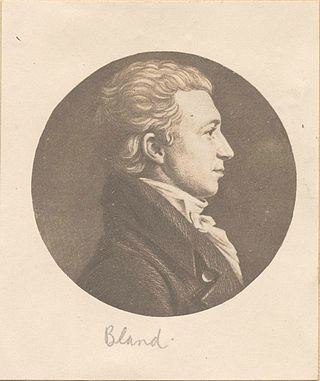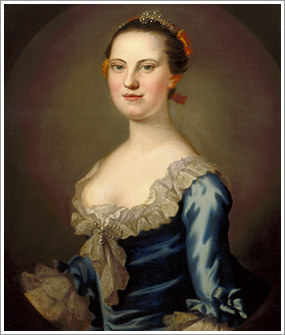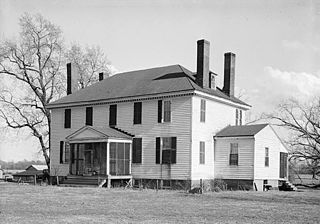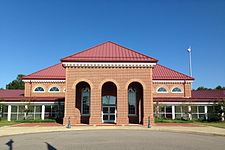
Prince George County is a county located in the Commonwealth of Virginia. As of the 2020 census, the population was 43,010. Its county seat is Prince George.

Goochland County is a county located in the Piedmont of the Commonwealth of Virginia. Its southern border is formed by the James River. As of the 2020 census, the population was 24,727. Its county seat is Goochland.

The Colony of Virginia was a British colonial settlement in North America between 1606 and 1776.

Theodorick Bland, also known as Theodorick Bland, Jr., was an American planter, physician, soldier, and politician from Prince George County, Virginia. A major figure in the formation of the new United States government, Bland represented Virginia in both the Continental Congress and the United States House of Representatives, as well as served multiple terms in the Virginia House of Delegates representing Prince George County, which he also represented in the Virginia Ratification Convention.

William Byrd I was an English-born Virginia colonist and politician. He came from the Shadwell section of London, where his father John Bird was a goldsmith. His family's ancestral roots were in Cheshire.
Carter Bassett Harrison was a politician from the U.S. state of Virginia.

Westover Plantation is a historic colonial tidewater plantation located on the north bank of the James River in Charles City County, Virginia. Established in c. 1730–1750, it is the homestead of the Byrd family of Virginia. State Route 5, a scenic byway, runs east–west to the north of the plantation, connecting the independent cities of Richmond and Williamsburg.

Edmund Ruffin III was a wealthy Virginia planter, amateur soil scientist, and political activist best known as an early advocate for secession of the southern slave states from the United States. He served in the Virginia Senate from 1823 to 1827. In the three decades before the American Civil War he published polemics in support of states' rights and the protection of chattel slavery, earning notoriety as one of the so-called Fire-Eaters. Ruffin was present at the Battle of Fort Sumter in April 1861 and fired one cannon shot at the fort. This gave rise to the legend that Ruffin fired the first shot of the Civil War. Ruffin did enlist as a Confederate soldier despite his advanced age. When the war ended in defeat in 1865, he committed suicide rather than accept what he called "Yankee rule."

Mary Willing Byrd was an American planter. At twenty years of age, she became the step-mother of five children and managed the family and household at Westover Plantation in Charles City County, Virginia beginning her second year of marriage. Together Byrd and her husband, William Byrd III, had ten more children before he committed suicide in 1777. She determined what property to hold on to and what to sell of what she inherited so that she could pay off debts, preserve Westover Plantation, and retain some land for the Byrd children.
Charles City was one of four incorporations established in the Virginia Colony in 1619 by the proprietor, the Virginia Company. In 1613, Bermuda City was founded, which was later renamed after Prince Charles. In 1634, under Royal authority, a portion became Charles City Shire, later Charles City County.

Piney Grove at Southall's Plantation is a property listed on the National Register of Historic Places in Holdcroft, Charles City County, Virginia. The scale and character of the collection of domestic architecture at this site recall the vernacular architectural traditions of the eighteenth, nineteenth and twentieth centuries along the James River.

John Minor Botts was a nineteenth-century politician, planter and lawyer from Virginia. He was a prominent Unionist in Richmond, Virginia, during the American Civil War.

Weyanoke is a plantation farmstead in Charles City County, Virginia, United States. In 1619, the First Africans in Virginia arrived at the Weyanoke Peninsula. They created the first African community in North America. The Westover Plantation and related archaeological sites were listed on the National Register of Historic Places in 1980.
Theodorick Bland, also known as Theodorick Bland of Westover, was a planter, merchant and politician in colonial Virginia who served as Speaker of the House of Burgesses, as well as in both houses of the Virginia General Assembly. The founder of the Bland family of Virginia, his son and grandson of the same name also served in the Virginia General Assembly before the American Revolutionary War, and later descendants sharing the same name would become a federal judge and congressman.

Westover Church is a historic church located 5 miles (8.0 km) west of Charles City off Virginia State Route 5 in Charles City, Virginia, United States. It was built in 1731 and added to the National Register of Historic Places in 1972.
Theodorick Bland, also known as Theodorick Bland, Sr. or Theodorick Bland of Cawsons, was Virginia planter who served as a member of the first Virginia Senate, as well as a militia officer and clerk of Prince George County, Virginia.

The planter class, also referred to as the planter aristocracy, was a racial and socioeconomic caste which emerged in the Americas during European colonization in the early modern period. Members of the caste, most of whom were settlers of European descent, consisted of individuals who owned or were financially connected to plantations, large-scale farms devoted to the production of cash crops in high demand across Euro-American markets. These plantations were operated by the forced labor of slaves and indentured servants and typically existed in subtropical, tropical, and somewhat more temperate climates, where the soil was fertile enough to handle the intensity of plantation agriculture. Cash crops produced on plantations owned by the planter class included tobacco, sugarcane, cotton, indigo, coffee, tea, cocoa, sisal, oil seeds, oil palms, hemp, rubber trees, and fruits. In North America, the planter class formed part of the American gentry.

Charles Hill Carter was a Virginia planter who represented Lancaster County in the Virginia House of Burgesses (1758–1775) and all five of the Virginia Revolutionary Conventions, and also sat on the first Council of State in 1776.






















